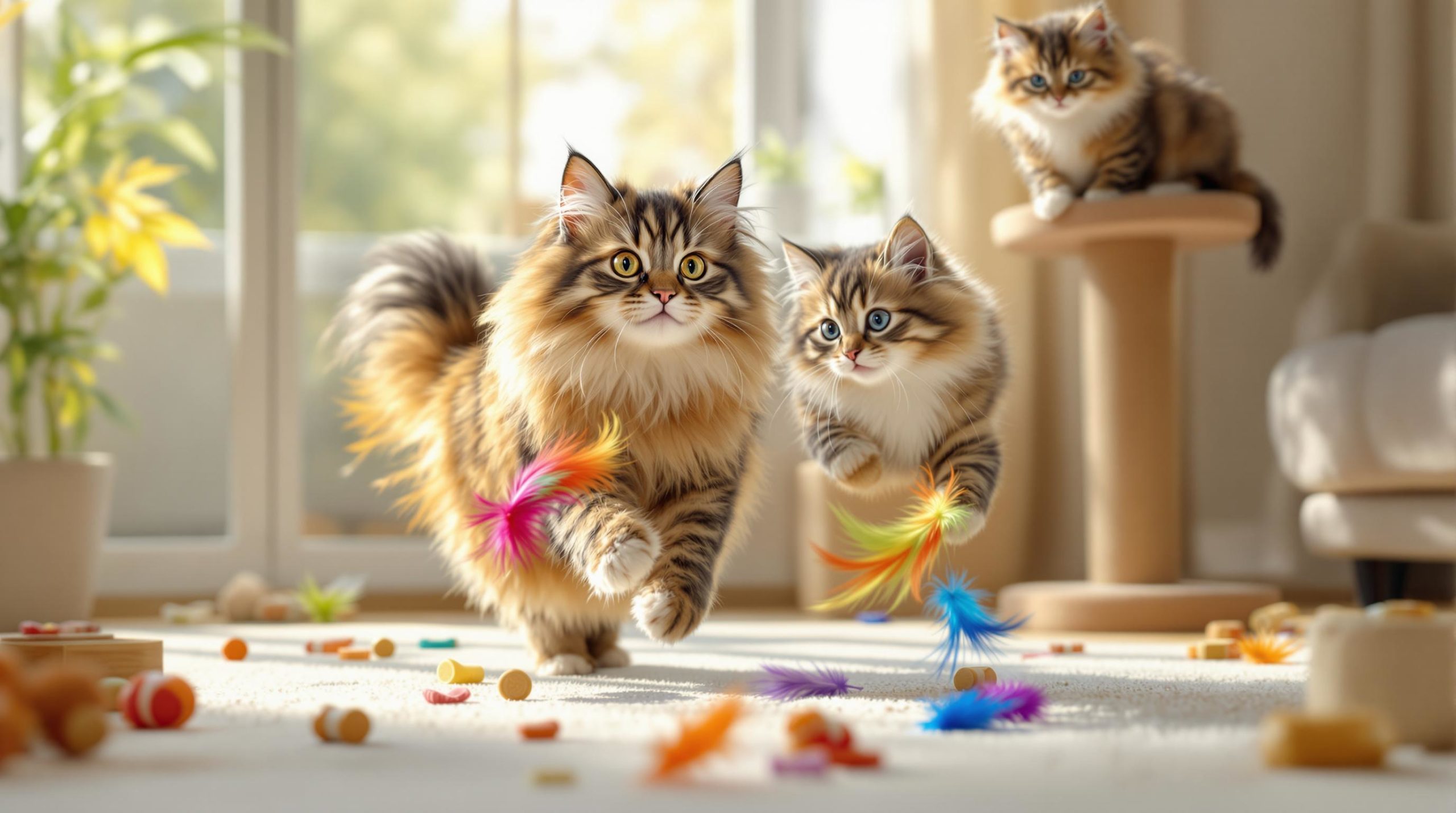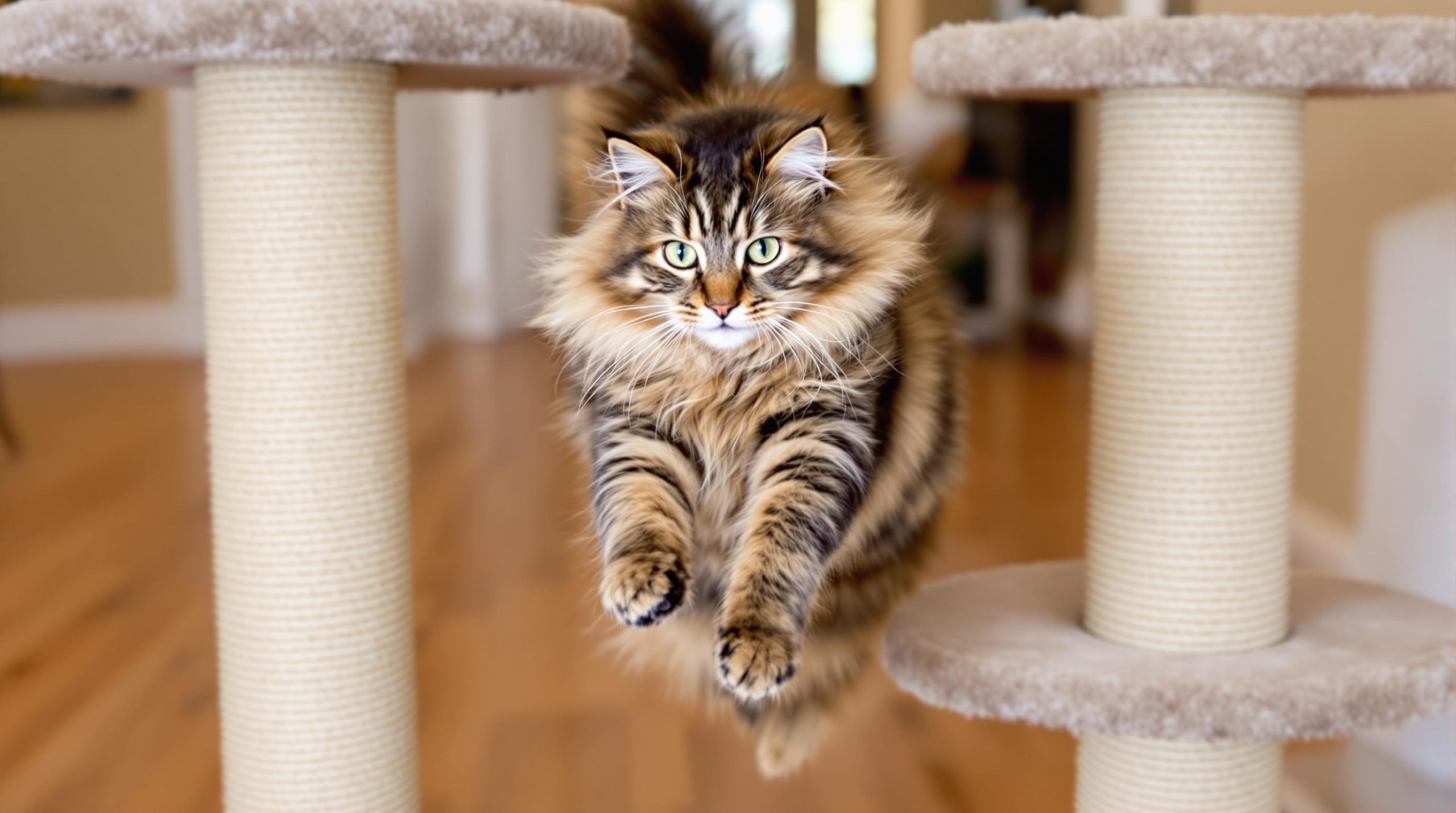How much exercise do Maine Coons really require? Here’s what you should know to keep them happy and healthy!

The Maine Coon, often called the gentle giant of the cat world, is a majestic breed with a spirit and energy level that may surprise those new to this magnificent feline. While their size and laid-back demeanor might give the impression that they need little exercise, maintaining an active lifestyle is crucial for their overall feline fitness and pet health. Keeping a Maine Coon physically and mentally stimulated is not a luxury but a necessity, especially for indoor cats whose environment lacks the natural challenges of the outdoors.
Owners and fans alike often wonder, “How much exercise does a Maine Coon truly need?” The answer is more nuanced than a simple daily time goal. Factors such as age, living space, and social interaction all influence how to best meet the cat exercise needs of these large, intelligent cats. This article delves into practical and effective approaches to enhancing Maine Coon care through tailored cat exercise and animal enrichment methods that benefit both pet and owner alike.
Understanding Maine Coon Exercise Requirements: Balancing Size, Temperament, and Activity
Maine Coons are celebrated for their remarkable size and dog-like personalities. They often show great affection and sociability, favoring interactive play with their human companions. Despite their gentle nature, these cats inherit a working-cat lineage that demands regular and engaging activity to keep muscles and joints in prime condition.
Meeting their physical exercise requirements is essential for several reasons:
- Weight management: These cats tend to gain excess weight, especially if neutered and confined indoors, which predisposes them to obesity-related conditions.
- Joint and muscle health: Being a large breed, maintaining mobility and avoiding stiffness is paramount to long-term health.
- Mental enrichment: Boredom without sufficient stimulation can lead to problematic behaviors like destructiveness or overgrooming.
- Prevention of health issues: Regular activity helps ward off diabetes, heart disease, and arthritis, common in sedentary cats.
Quantifying the actual amount of exercise depends largely on the cat’s environment. Indoor-only Maine Coons often require more deliberate exercise sessions, typically between 30 to 45 minutes daily. This entails intentional interactive play using specialized cat toys and engagement strategies, which can be found with useful advice at Maine Coon Exercise Needs.
Indoor/outdoor cats benefit from natural movement but still appreciate human-led play sessions lasting around 20 to 30 minutes. Completely outdoor cats usually self-regulate, getting sufficient exercise through roaming and exploring their territory, though regular monitoring is advised.
| Living Environment | Recommended Daily Exercise | Exercise Approach |
|---|---|---|
| Indoor Only | 30–45 minutes | Interactive play, climbing spaces, puzzle feeders |
| Indoor/Outdoor Hybrid | 20–30 minutes | Human-led play, supervised outdoor exploration |
| Outdoor Only | Natural roaming | Self-regulated exploration and hunting |
One cannot underestimate how important an active lifestyle combined with quality pet nutrition is to ensure Maine Coons thrive. For more on combining diet with exercise, here’s a guide on managing weight and fitness effectively.

Interactive Play: The Cornerstone of Maine Coon Feline Fitness and Mental Stimulation
Interactive play is arguably the most effective way to satisfy the exercise needs of a Maine Coon. These cats adore games that simulate hunting behavior such as chasing, pouncing, and stalking. Engaging in such activities not only stimulates their muscles but also their problem-solving instincts.
Some stellar toys to include in their playtime are:
- Feather wands: Ideal for mimicking prey movements, triggering hunting sequences.
- Laser pointers: Great for energetic cats, but avoid shining the laser directly in their eyes and always end sessions with a tangible toy to catch.
- Kicker toys and toy mice: These satisfy the innate urge to grasp and wrestle prey.
- Puzzle feeders: Combine mental effort with physical activity, perfect for mealtime enrichment.
Because Maine Coons are highly intelligent, they often learn quickly and can even master playing fetch, a game usually reserved for dogs. Rotating toys weekly helps maintain novelty and avoid boredom. The importance of interactive play for these smart cats is well documented, as noted on Maine Coons and Play Behavior.
Establishing a routine with short play bursts—15 to 20 minutes twice per day—can encourage consistency and keep your cat agile and alert.
| Type of Toy | Purpose | Benefits |
|---|---|---|
| Feather Wands | Mimics prey | Stimulates hunting behavior, improves agility |
| Laser Pointers | Encourages fast chasing | Enhances reflexes, cardiovascular fitness |
| Puzzle Feeders | Combines feeding with problem-solving | Mental stimulation, slows eating |
| Kicker Toys | Satisfies prey capture instincts | Strengthens muscles, behavioral outlet |
Enhancing Physical Exercise Through Environmental Enrichment and Play Spaces
Maine Coon cats are natural climbers and explorers. As such, providing vertical spaces like tall, sturdy cat trees and wall shelves offers essential opportunity for vigorous activity and exercise. Multi-level structures allow your Maine Coon to jump, stretch, and perch safely high up, engaging muscles that wouldn’t be used as often on flat ground.
When selecting a cat tree, look for these key features:
- Height of 5 feet or more: Supports natural climbing instincts and exercise.
- Extra-wide perches: At least 16 inches wide to accommodate large bodies comfortably.
- Strong base: Ensures stability during active play and vigorous jumping.
- Sisal-covered scratching posts: Protects furniture while encouraging healthy claw maintenance.
Beyond static structures, some enrichments add a dynamic element to your cat’s exercise routine:
- Cat exercise wheels: Perfect for high-energy Maine Coons, providing space to run indoors safely.
- Agility tunnels: These encourage sprinting and exploration, keeping your cat curious and physically engaged.
- Motion-activated toys: Stimulate natural hunting behavior even when you’re busy.
Incorporating these enrichments fosters an environment that supports both physical and mental health. For those raising their Maine Coon indoors, capturing and converting natural instincts into daily exercise helps prevent many behavior problems and ailments. There’s an excellent resource detailing this at Indoor/Outdoor Maine Coon Exercise Tips.

Safe Outdoor Exercise: Harness Training and Adventure Walking with Maine Coons
Although indoor exercise is important, safely exploring the outdoors offers unbeatable stimulation for a Maine Coon’s body and mind. Many owners successfully harness-train their cats, enabling 15–30 minute escorted walks that tap into their natural curiosity and hunting instincts.
Key tips for harness training include:
- Start young, introducing the harness gradually.
- Use a vest-style harness with secure straps to prevent escape.
- Keep early sessions short and rewarding with treats and praise.
- Avoid busy or loud areas to reduce stress.
Besides physical exercise, outdoor walks strengthen the human-animal bond and encourage calm indoor behavior thereafter. However, not all Maine Coons suit this lifestyle, and owners should respect their cat’s comfort level.
Alternatively, supervise outdoor time in secure, enclosed gardens or cat patios (“catios”) where they can safely roam and play. This blend of protection and freedom is again a natural way to meet feline fitness needs.
The benefits and how to train your Maine Coon for these enriching outdoor activities are well explained at Training Maine Coon Tips.
| Harness Training Step | Purpose | Notes |
|---|---|---|
| Introducing Harness | Familiarize cat with gear | Reward calm reactions with treats |
| First Outdoor Steps | Gradual exposure to outside | Short, quiet walks preferred |
| Confident Walks | Increase duration and explore | Observe stress signs and adjust |
Identifying Exercise Needs and Signals: Is Your Maine Coon Getting Enough Activity?
Recognizing when your Maine Coon craves more exercise can prevent many behavioral and health issues. Watch for signs such as:
- Destructive scratching or furniture damage: Often linked to pent-up energy.
- Restlessness or sudden bursts of “zoomies”: High-energy sprints indicate the need for more playtime.
- Excessive vocalization: An attempt to get your attention for interaction.
- Obesity or lethargy: Physical health symptoms often tied to inactivity.
- Overeating from boredom: Emotional eating can stem from lack of stimulation.
Responding by increasing interactive play, providing new cat toys, and mental challenges usually front-load improvements within weeks. For seniors or cats dealing with joint issues, adapted Maine Coon care strategies exist to maintain gentle activity while respecting mobility limits, covered in detail at Caring for Senior Maine Coons.
Behavioral cues showing a Maine Coon’s desire to play include tail twitching, gentle nipping, chirping, stalking posture, and bringing toys to you. Understanding these signs fosters a strong bond and helps tailor exercise routines to your cat’s individual personality. Dive deeper into Maine Coon intelligence and communication at Maine Coons Intelligence and Play.
| Behavioral Sign | Meaning | Recommended Response |
|---|---|---|
| Zoomies | Sudden energy burst | Initiate play session |
| Tail Twitching | Anticipation/excitement | Engage with toys |
| Gentle Biting | Play invitation | Wrestle gently or provide a toy |
| Chirping/Trilling | Invitation to interact | Follow up with play or petting |
| Bringing Toys | Request for play | Join in interactive play |
FAQ About Maine Coon Exercise and Well-being
- How often should I exercise my indoor Maine Coon?
At least 30 to 45 minutes daily of interactive play spread into short sessions is ideal to mimic their natural instincts and promote pet health.
- Can Maine Coons become over-exercised?
Yes, particularly kittens might play to the point of exhaustion. Watch for signs like agitation or aggression and end play sessions on a calm note.
- Does age affect exercise requirements?
Absolutely. Senior Maine Coons need gentler activities and possibly less time, focusing more on mobility and joint health as advised by vets.
- Are outdoor walks safe for Maine Coons?
When properly harness-trained using secure, escape-proof gear and gradual exposure, outdoor walks can be enriching and safe.
- What are the best toys for Maine Coon exercise?
Feather wands, laser pointers, kicker toys, and puzzle feeders are excellent choices to satisfy their physical and mental needs.